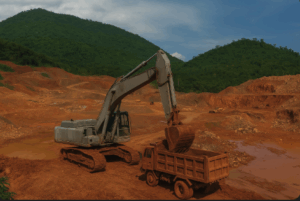BANGKOK / KUALA LUMPUR ã Beneath Southeast Asiaãs ancient rainforest-clad hills, where river systems sustain millions and extraordinary biodiversity endures, lies a treasure of value to modern superpowers: rare-earth elements (REEs). Minerals like neodymium, dysprosium and yttrium power everything from electric vehicles to missile guidance systems.
With the world scrambling to diversify supply chains away from Chinaãstill dominant in REE extraction and processingãWashington has made a bold push into the region. In late October 2025, the United States signed memorandums of understanding (MOUs) with Thailand and Malaysia, giving American firms preferential access to new rare-earth discoveries and promising to ãreview and deter certain critical minerals and rare earths asset sales on national-security grounds.ã
But the rapid pace and strategic framing of these agreements have sparked concern in both countries: Are they being dragged into a new ãdig-and-dumpã model? And who really stands to benefitãthe foreign investors or the local communities and environments?
Malaysiaãs Promise ã And Unease
Malaysia holds an estimated 16 million metric tons of rare-earth deposits, according to governmentãlinked estimates. The government, keen to develop mid-stream processing capabilities, says it will not export raw materials indefinitely and emphasises attracting foreign investment and value-added processing. Trade Minister Tengku Zafrul Aziz told parliament that Malaysia ãno longer wants to be a country that only digs and ships out cheap raw materials like in the past.ã
Yet the MOU with the U.S. reportedly contains a clause that prohibits quotas or export restrictions of critical minerals to American companies ã a condition that seemed to conflict with Malaysiaãs public policy. Environmental watchdogs caution that many of Malaysiaãs deposits lie beneath high-value forest reserves in states such as Terengganu, Kelantan, Pahang, Perak and Kedah ã places where mining could damage fragile ecosystems and indigenous rights.
A legacy of mining-related pollution hangs in the background: Malaysia has faced major environmental scandals tied to bauxite and rare-earth waste dumping. For critics the question is clear: will the rush for rare earths replicate the mistakes of old, now on a far larger scale?
Thailandãs Strategic PositioningãCautious Embrace
Thailand, though possessing far smaller known reserves of rare earths, has signed a similar cooperation agreement with the U.S. Bangkok emphasises the deal is non-binding, and that any future investment must comply with Thai laws on environment and public health, according to the Ministry.
Still, environmentalists warn that upstream extraction operations in neighbouring Myanmar already send pollution across borders into northern Thailand. One recent report flagged elevated arsenic levels in water systems flowing into Thailand from Shan State mining sites. Thailandãs government is framing its role as a ãprocessing hubã rather than a raw-exporter, and hopes to capture value along the supply chain. But critics say the regulatory framework remains thin and the timeframe ambitious.
Geopolitics, Economics ã and the Environmental Risk
For the United States, these agreements mark an assertive pivot in mineral diplomacy. With China controlling roughly 60-70 % of global REE mining and about 90 % of processing capacity, diversifying sources has become an economic and strategic imperative.
Yet extraction of rare earths is far from benign. Studies show REE mining can generate large volumes of toxic and radioactive waste, require vast amounts of water and energy and lead to soil, air and water contamination. This is especially worrying in biologically rich and hydrologically sensitive Southeast Asian landscapes.
In Malaysia, one author highlights that the current policy framework lacks meaningful protections for local communities and biodiversity when it comes to rare-earth development. ô In Thailand, the cross-border environmental impacts from Myanmarãs mining highlight how regional regulatory gaps can magnify risk.
Economically, the big questions remain: Will these Southeast-Asian countries manage to capture the high-value processing stepsãor will they become extraction sites with little downstream benefit? Governments say they aim for domestic value-addition; but investors warn that infrastructure, technology and regulatory lag remain real obstacles.
Domestic Pushback and Political Stakes
In Malaysia, opposition lawmakers and civil-society groups warn of sovereign rights being ceded too easily. One critic called the MOUãs language ãa green-light to expand mining unchecked.ã In Thailand, lawmakers emphasise that terminating agreements with powerful partners like the U.S. may pose political and legal complexity. For both countries the issue is not simply economic: it involves communities, environment, territorial sovereignty and national identity.
What Lies Ahead?
ã Regulatory oversight: Will Thailand and Malaysia enforce stringent environment and social impact assessments before mining begins?
ã Value-chain capture: Can ASEAN countries shift from raw-material export to processing, magnet production and recycling?
ã Environmental protection: Will mining avoid forest reserves, protect watersheds and respect indigenous/community rights?
ã Geopolitical balance: Can ASEAN countries manage competing pressures from the U.S. and China without compromising their autonomy?
ã Time horizon: Scaling upstream mining and downstream processing generally takes years. Observers caution that real output from Thailand/Malaysia may still be a decade away.
As the worldãs appetite for rare earths surgesãdriven by electric vehicles, wind turbines, next-generation electronics and defence systemsãthe stakes for Southeast Asia are high. For Thailand and Malaysia, the epochal question is whether they can translate mineral riches into sustainable growth, without repeating the extractive mistakes of the past. And for the United States, whether its rush for supply is compatible with the environmental and societal realities of its new partners. (zai)

